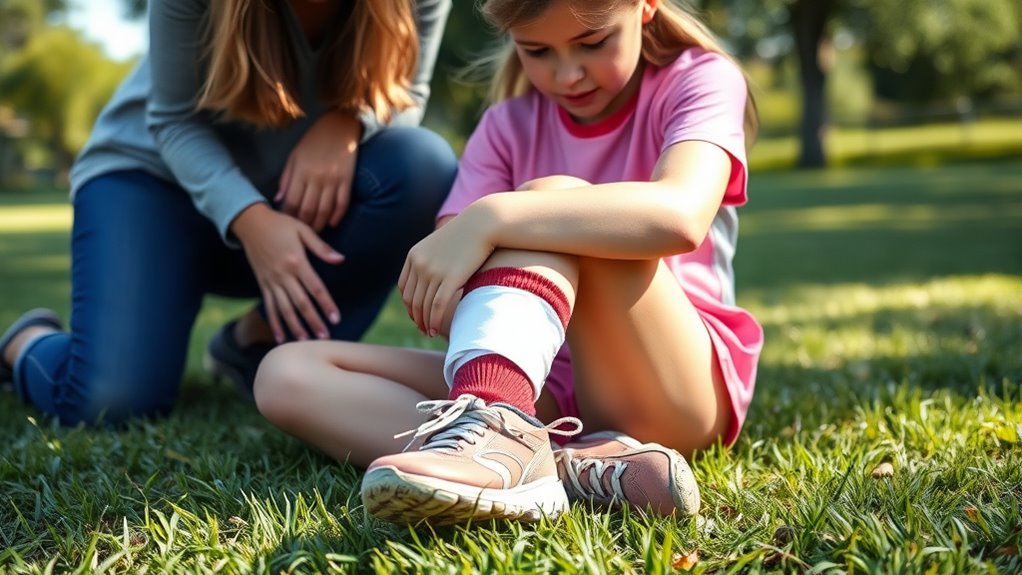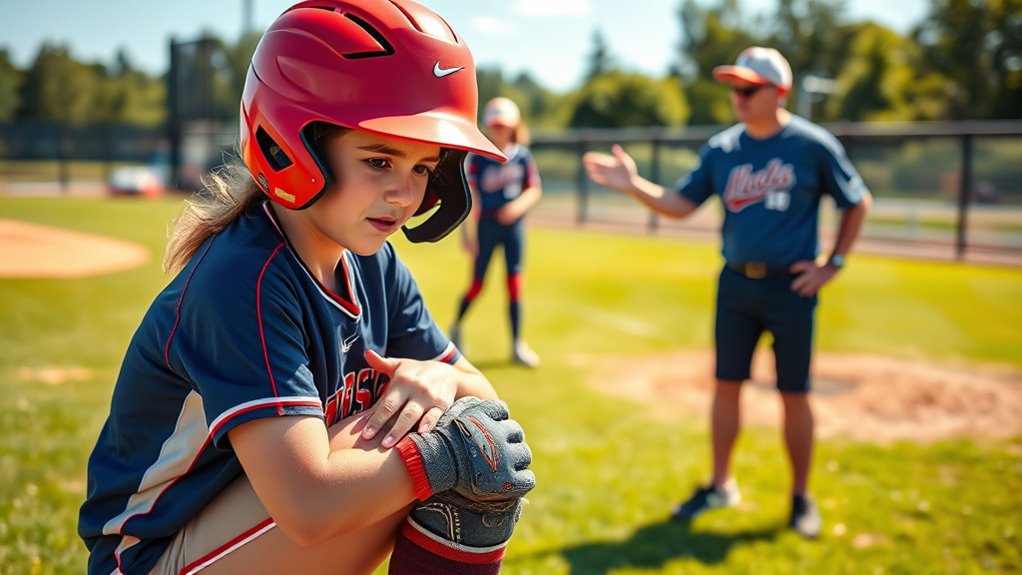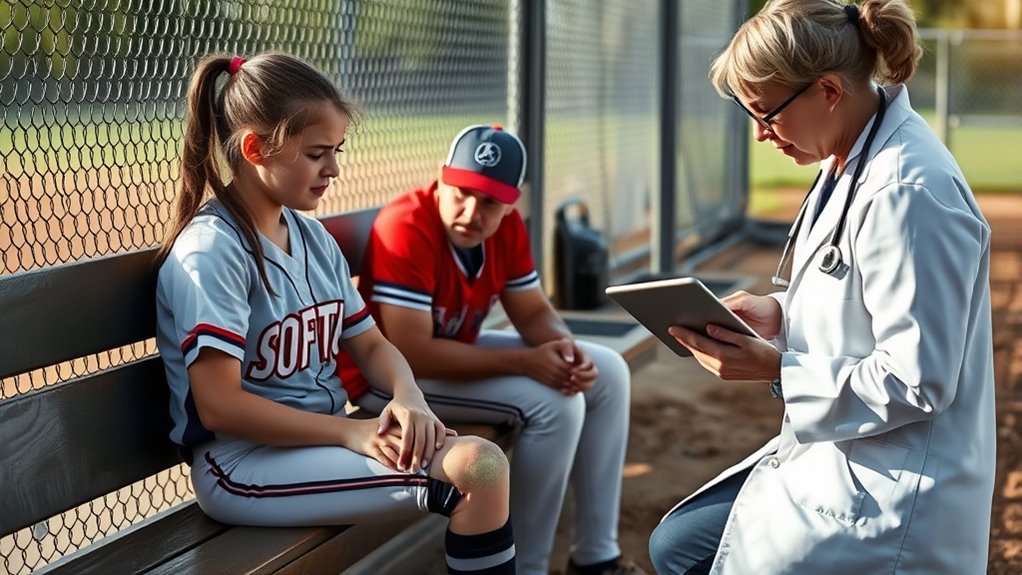Injuries are common in youth softball, but you can help your child recover quickly and safely. Recognize signs like pain, swelling, or limited mobility and respond promptly by stopping play and applying the R.I.C.E. method—rest, ice, compression, and elevation. Seek medical attention if symptoms worsen or seem serious. Supporting their recovery with proper rest, gradual activity, and open communication helps prevent future injuries. Keep these tips in mind to guarantee your child’s safe return to the game.
Key Takeaways
- Recognize injury signs early, such as pain, swelling, or limited movement, and respond promptly with R.I.C.E. methods.
- Ensure proper medical assessment for severe injuries, including fractures or head impacts, to prevent long-term damage.
- Support your child’s recovery with rest, hydration, gentle activity, and open communication about their feelings and progress.
- Follow healthcare provider instructions carefully, gradually reintroducing activity to prevent setbacks and ensure full healing.
- Coordinate with coaches and medical professionals, sharing updates and recovery plans for a safe and confident return to play.
Recognizing Common Softball Injuries in Young Players

Softball players, especially young ones, are prone to specific injuries that can hinder their performance and development. Recognizing these injuries early is vital for effective injury prevention. Common issues include sprains, strains, and fractures, often caused by sudden impacts or improper technique. Overuse injuries like shoulder or elbow tendinitis are also frequent, especially without proper rest. Wearing protective gear such as helmets, gloves, and padding helps minimize the risk of serious injuries. Pay close attention to signs of pain, swelling, or limited mobility, as these can indicate underlying problems. Additionally, understanding injury prevention strategies is crucial in keeping young athletes safe. By understanding these common injuries and emphasizing injury prevention strategies, you can help your young player stay safe and healthy on the field. Proper gear and awareness are your first steps toward injury prevention.
Immediate Steps to Take After an Injury Occurs

When an injury happens during a game or practice, taking quick, effective action can prevent further damage and promote faster recovery. Your first step is to assess the situation calmly. Use safety equipment like pads or braces if available to stabilize the injury and prevent aggravation. Apply the R.I.C.E. method: Rest, Ice, Compression, and Elevation. This helps reduce swelling and pain. Keep injured players from moving too much to avoid additional harm. Ensuring proper injury prevention measures, such as wearing appropriate safety equipment, can lessen injury severity. Remember, acting swiftly and correctly can make a significant difference in recovery time and future safety. Proper emergency response is essential for effective injury management.
When to Seek Professional Medical Attention

Knowing the signs that indicate serious injury is essential for guaranteeing proper treatment and recovery. If your child experiences severe pain, inability to move the injured area, persistent swelling, or if there’s an obvious deformity, seek medical attention immediately. Also, watch for signs of concussion, like dizziness, confusion, or loss of consciousness. Timely professional care is vital to prevent long-term damage. Proper sports nutrition supports healing and injury prevention, so ensure your child maintains a balanced diet to aid recovery. Don’t hesitate to consult healthcare professionals if symptoms worsen or don’t improve quickly. Recognizing when to seek help guarantees your child gets the appropriate treatment and reduces the risk of complications, helping them return to the game safely and swiftly.
Managing Pain and Swelling at Home

To manage pain and swelling at home, start by applying ice packs and keeping the injured area elevated. Over-the-counter remedies like pain relievers can also help reduce discomfort. These simple steps can make a big difference in your recovery process. Using properly maintained equipment, such as clean and effective ice packs, can further enhance your comfort and healing.
Ice and Elevation
Applying ice and elevating your injured shoulder are simple yet effective ways to manage pain and reduce swelling at home. Ice therapy helps constrict blood vessels, decreasing inflammation and numbing nerve endings to ease discomfort. Use an ice pack wrapped in a cloth for 15-20 minute intervals every few hours. Elevation techniques involve keeping your shoulder raised above heart level whenever possible, which encourages fluid drainage and minimizes swelling. Rest your shoulder and avoid activities that cause pain. Combining ice therapy with elevation provides immediate relief and supports the healing process. Remember to listen to your body—if swelling or pain worsens, consult a healthcare professional. Proper Pimple Patch application can also prevent infection and promote faster healing of skin injuries. These simple steps can make a significant difference in your recovery at home.
Over-the-Counter Remedies
Over-the-counter (OTC) remedies can effectively manage pain and reduce swelling during your softball injury recovery. Non-prescription options like ibuprofen or acetaminophen help ease discomfort and lower inflammation. Applying OTC creams or gels with ingredients such as menthol or capsaicin can provide localized relief. For additional home remedies, consider herbal solutions like arnica or comfrey ointments, which have natural anti-inflammatory properties. Resting the injured area and using gentle compression can complement these remedies to speed healing. Always follow dosing instructions and consult your healthcare provider if pain persists or worsens. Recognizing the importance of fatherhood and supportive care can also contribute to a more positive recovery experience. Combining OTC remedies with proper rest and herbal solutions can make your recovery more comfortable and support faster healing.
The Importance of Rest and Gradual Return to Play

Rest is essential for a full recovery, so don’t rush back too soon. You should carefully manage your return to play by listening to your body’s signals and avoiding pain. Prioritizing your healing guarantees you can get back to softball safely and prevent setbacks. Monitoring your air quality can also help ensure a healthy environment during recovery.
Prioritize Full Recovery
Recovering from a softball injury requires patience and careful planning to guarantee a full return to play. You must give your body time to heal completely, avoiding the temptation to rush back. Focus on:
- Following your healthcare provider’s advice strictly.
- Incorporating proper injury prevention strategies to avoid setbacks.
- Reinforcing sportsmanship etiquette by respecting your recovery process and teammates.
- Gradually increasing activity levels, listening for signs of strain or pain.
- Using appropriate training equipment to support your recovery and prevent re-injury.
Prioritizing full recovery not only prevents future injuries but also ensures you play safely and confidently again. Remember, rushing back too soon can cause setbacks, so patience is key. A strong, healed body supports better injury prevention strategies and helps you maintain good sportsmanship etiquette on and off the field.
Manage Return Timeline
After focusing on a full recovery, it’s important to carefully manage your return to play. Rushing back too soon can risk reinjury or new injuries, so establish a gradual timeline that prioritizes injury prevention. Rest is essential, but so is monitoring progress through injury documentation. Keep detailed records of your child’s healing milestones and any lingering discomfort. This documentation helps guide safe progression and ensures everyone stays aware of recovery status. Reintroduce activity slowly, starting with light drills and increasing intensity only when cleared by a healthcare professional. Patience during this phase minimizes setbacks and promotes sustainable recovery. By respecting the timeline and focusing on injury prevention, you give your child the best chance for a safe, full return to softball.
Listen to Body Signals
Listening to your child’s body signals is essential during their return to softball, as it helps prevent setbacks and further injury. Pay attention to signs like muscle fatigue, which can indicate overexertion. Here are key ways to support their recovery:
- Notice if they experience persistent soreness or weakness after activity.
- Encourage regular hydration, using hydration tips like drinking water before, during, and after practice.
- Allow adequate rest days to let muscles recover fully.
- Watch for any discomfort that worsens with activity, signaling it’s time to pause.
- Understanding the developmental stages can guide appropriate activity levels and recovery strategies.
Supporting Emotional Well-being During Recovery

Maintaining your emotional well-being is an essential part of the injury recovery process. As a parent, your support can help your child build emotional resilience, which is critical during setbacks and frustration. Encourage open communication, letting them express their feelings without judgment. Reassure your child that setbacks are normal and focus on small achievements to boost their confidence. Your active involvement and positive attitude can help them stay motivated and hopeful. Recognize signs of emotional distress early and address them compassionately. Remember, your support creates a safe space for your child to process emotions, making recovery smoother. Additionally, understanding the benefits of eye patch benefits, such as reducing puffiness and providing hydration, can serve as a useful analogy for emphasizing the importance of caring for oneself during recovery. Together, you can foster resilience that not only aids recovery but also strengthens their mental well-being for future challenges.
Preventative Measures to Reduce Future Injuries

Implementing preventative measures is essential to reducing the risk of future softball injuries. You can protect your player by emphasizing proper warm-up routines that increase blood flow and loosen muscles before play. Additionally, make sure she always wears appropriate protective gear, such as helmets, shin guards, and gloves, to prevent injuries. Here are four key strategies:
- Develop thorough warm-up routines that include stretching and light activity.
- Use well-fitted protective gear for every game and practice.
- Incorporate strength training to build muscle support around vulnerable joints.
- Teach proper techniques for batting, catching, and sliding to avoid overuse and impact injuries. Proper technique training can also help prevent injury risks associated with improper movements.
Communicating With Coaches and Healthcare Providers

Effective communication with coaches and healthcare providers is vital for guaranteeing your player’s safe recovery and ongoing health. You should promptly report injuries to coaches, providing clear details about how it happened and the symptoms your child is experiencing. Accurate injury reporting helps coaches make informed decisions about rest, play restrictions, and treatment. Additionally, maintaining thorough medical documentation is essential. Keep copies of doctor’s notes, treatment plans, and recovery progress. Share this information with coaches to ensure everyone is on the same page and your child receives appropriate care. Open communication also allows healthcare providers to monitor progress, adjust treatment, and prevent future injuries. Staying proactive and organized helps facilitate a smooth recovery process, giving your child the best chance to return safely to the game.
Frequently Asked Questions
How Can I Tell if My Child’S Injury Is Serious Enough for Emergency Care?
If you’re unsure whether your child’s injury needs emergency care, prioritize injury prevention by watching for severe symptoms. Look for signs like heavy bleeding, intense pain, swelling, or inability to move the affected area. Trust your parental communication instincts—if something feels off or if your child is unresponsive or shows signs of distress, seek emergency help immediately. When in doubt, it’s better to obtain professional assessment to ensure safety.
Are There Specific Signs Indicating a Concussion in Young Softball Players?
When checking for a concussion in your young softball player, watch for symptoms monitoring closely. Concussion symptoms can include headache, dizziness, nausea, confusion, or sensitivity to light and sound. If you notice any of these signs after an injury, seek medical attention promptly. Always err on the side of caution, and don’t hesitate to consult a healthcare professional if you suspect a concussion.
What Are Effective Home Remedies to Speed up Soft Tissue Injury Recovery?
Did you know that most soft tissue injuries recover faster with proper care? To speed up healing at home, focus on rest, ice, compression, and elevation—commonly known as RICE. You can also try gentle stretching and massage to improve blood flow. These home remedies help reduce swelling, relieve pain, and promote faster recovery, so your young athlete gets back on the field sooner and stronger.
How Long Should My Child Rest Before Returning to Softball After an Injury?
You should wait until your child’s injury severity assessment indicates they’re ready to return to play. Follow return to play protocols carefully, which often involve a gradual increase in activity levels. Rest periods vary depending on the injury’s severity, but never rush back too soon, as doing so risks setbacks. Consult with a healthcare professional for personalized guidance, ensuring your child’s full recovery before resuming softball.
What Psychological Support Options Are Available for Injured Young Athletes?
When facing setbacks, remember that resilience is a garden needing nurturing. You can explore peer support groups where injured athletes share experiences, easing feelings of isolation. Counseling options, like sports psychologists, help your child process emotions and rebuild confidence. These tools act as anchors during tough times, reminding your young athlete they’re not alone. Supporting their mental health is as crucial as physical recovery, fostering strength from within to return stronger.
Conclusion
Remember, every stumble is a chance to learn and grow stronger. By paying close attention, giving your young athlete time to heal, and staying connected with coaches and healthcare providers, you help them bounce back even brighter. Think of injuries as gentle detours on their journey—moments to pause, reflect, and come back more resilient. With patience and care, you’ll guide them toward a future filled with confidence and joy on the field.









